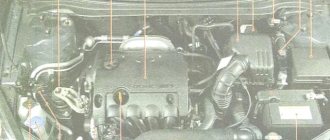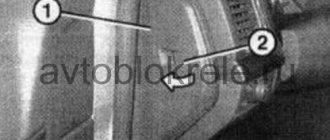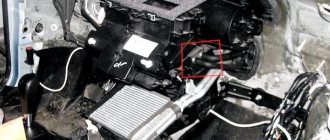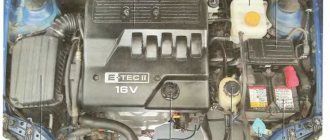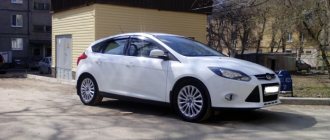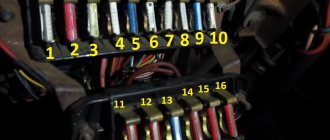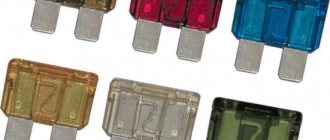On Ford Focus 2 cars, fuses are located in two blocks, which are located under the hood and in the passenger compartment at the passenger's feet. You can better understand the location in the picture below.
In order to gain access to the fuses in the block under the hood, you need to pull the lever on the side of the windshield and lift the cover up.
On the cover itself there is a diagram of the location of fuses and relays. Now let’s take a closer look at what each fuse and relay is responsible for.
Fuse and relay assignment diagram for Ford Focus 2 Restyling and pre-restyling
| № | Denomination (A) | Purpose of the fuse |
| F1 | 40A | Ford Focus 2 cooling fan fuse |
| F2 | 80A | Electric power steering |
| F3 | 60A | Power supply to interior fuse box 1 |
| F4 | 60A | Power supply to interior fuse box 2 |
| F5 | 80A | Manual air conditioning and climate control |
| F6 | 60A | Glow plugs for cars with diesel engines |
| F7 | 30A | ABS system, hydraulic pump |
| F8 | 20A | ABS system, hydraulic valves |
| F9 | 20A | Powertrain Control Module (PCM) |
| F10 | 30A | Ford Focus 2 Heater Fuse (Heater Fan) |
| F11 | 20A | Ignition switch (tidy and starter) |
| F12 | 40A | Ignition relay power circuit |
| F13 | 20A | Ford Focus 2 starter fuse |
| F14 | 40A | Heated right side of windshield |
| F15 | 30A | Cooling fan relay for vehicles without air conditioning |
| F16 | 40A | Heated left side windshield |
| F17 | 30A | On cars with a convertible body - a folding roof |
| F18 | 30A | Inverting power amplifier |
| F19 | 10A | ABS control unit |
| F20 | 15A | Sound signal |
| F21 | 20A | Additional heater |
| F22 | 10A | Control amplifier module |
| F23 | 30A | Headlight washer pump |
| F24 | 15A | Auxiliary heater - on diesel vehicles |
| F25 | 10A | Ignition relay/heated windshield relay coil |
| F26 | 15A | Automatic transmission |
| F27 | 10A | Air conditioning compressor clutch |
| F28 | 10A | For vehicles with a diesel engine - glow plug control |
| F29 | 10A | Separate climate control system |
| F30 | 3A | Engine control unit, automatic transmission control unit |
| F31 | 10A | Intelligent battery charging system |
| F32 | 10A | Automatic transmission control unit, selector lever position sensor |
| F33 | 10A | On cars with gasoline engines - oxygen sensor heater fuse (lambda probe) |
| F34 | 10A | Power supply for injectors and ignition coils |
| F35 | 10A | Engine management system |
| F36 | 10A | The engine control unit |
Purpose of the relay in the engine compartment of Ford Focus 2
| No. Relay | Purpose |
| R1 | On some cars, the engine start prohibition system |
| R2 | Ford Focus 2 Horn Relay |
| R3 | Reversing light relay (for some models) |
| R4 | Reserve – or “Start-Stop” system |
| R5 | Exhaust gas recirculation (EGR) relay - for gasoline engines Fuel Heater Relay - Diesel |
| R6 | Main relay |
| R7 | Heated windshield relay |
| R8 | Ignition relay |
| R9 | Headlight washer relay |
| R10 | Heater Fan Relay |
| R11 | A/C compressor relay |
| R12 | cooling fan motor relay, glow plug relay - diesel |
| R13 | Starter relay |
| R14 | Cooling fan relay. Electric fan motor |
Location of additional fuse box in Ford Focus 2
To gain access to the fuses in the passenger compartment, you need to remove the decorative cover under the glove box, at the passenger's feet.
Then, turning the fastening clips 90 degrees, lower the block and thereby gain access to the fuses.
Underhood fuse module
The first fuse box for Ford Focus 2 is located near the driver's fender under the hood, near the battery. To check or replace the PCB, you need to remove the cover and use tweezers attached to its reverse side. Relays and large fuses can be reached by hand.
On the inside there is a diagram of the location of the PP. It fades over time, in which case you can print a new one and attach it to the lid.
Decoding the engine compartment fuse module for the Ford Focus 2
| № | Denomination, A | Device or circuit being protected |
| 1 | 40 | Coolant fan motor |
| 2 | 80 | Electric power steering |
| 3 | 60 | Cabin module PP |
| 4 | 60 | Cabin module PP |
| 5 | 80 | Climate control, air conditioning |
| 6 | 60 | Spare connector |
| 7 | 30 | ABS unit electric pump |
| 8 | 20 | ABS valve body |
| 9 | 20 | Main Relay, winding |
| 10 | 30 | Heater fan motor |
| 11 | 20 | Engine power supply breaker |
| 12 | 40 | Engine start power connector |
| 13 | 20 | Starter fuse |
| 14 | 40 | Right heated windshield |
| 15 | 25 | Auxiliary radiator fan relay |
| 16 | 40 | Left heated windshield |
| 17 | 0 | Spare connector |
| 18 | 0 | Spare connector |
| 19 | 10 | ABS system, control unit |
| 20 | 15 | Klaxon |
| 21 | 25 | Webasto, for cars with northern preparation |
| 22 | 10 | Electric power steering, Control unit |
| 23 | 30 | Headlight cleaner nozzle pump |
| 24 | 15 | Spare connector |
| 25 | 15 | Heated windshield relay, power winding |
| 26 | 10 | ECU fuse for cars with automatic transmission |
| 27 | 10 | Air conditioner clutch drive |
| 28 | 10 | Spare connector |
| 29 | 10 | Climate controller control |
| 30 | 3 | Engine, ECU. Automatic transmission, ECU |
| 31 | 15 | Battery charge controller fuse |
| 32 | 10 | Automatic transmission rocker position selector |
| 33 | 15 | Lambda probe heating |
| 34 | 15 | Coils, electric fuel injectors |
| 35 | 15 | Engine, control unit |
| 36 | 10 | ECU |
Why does the cigarette lighter fail?
There are several reasons.
- Connecting too powerful equipment. Some car enthusiasts connect high-performance vacuum cleaners and refrigerators to the cigarette lighter socket. The fuse may not withstand the load and burn out.
- Water getting into the wiring. The device is sensitive to condensation and water ingress.
- Mechanical damage to wiring. Cracks in insulation and breaks in power lines.
- Burnt out filament of the cigarette lighter itself.
In-cabinet mounting block PP
In Ford Focus 2, the internal fuse module is located on the passenger side under the glove compartment (glove compartment). In cars manufactured from 2004 to 2007 (pre-styling), to check and replace the PP, you need to pull the latches and remove the top cover. There is a lock there, by turning which you can lower the entire module.
Pinout of the PP of the internal module in the second generation Ford Focus until 2007.
| Device or circuit being protected | Denomination, A | № |
| Headlight, Left high beam lamp | 15 | 37 |
| Headlight, High beam right | 15 | 38 |
| Add. socket, cigarette lighter | 25 | 39 |
| Hatch servo drive | 20 | 40 |
| Front right door, electrical module fuse | 20 | 41 |
| Heated exterior mirrors | 10 | 42 |
| +12V for electrical equipment from the battery | 10 | 43 |
| OBD2 connector, diagnostics | 10 | 44 |
| Bulbs for dimensions | 10 | 45 |
| +12V to the dashboard from the battery | 10 | 46 |
| Windshield washer motor, heated washer nozzles | 15 | 47 |
| Low beam bulbs, daytime running lights | 20 | 48 |
| Light switch +12V from battery | 15 | 49 |
| Front windshield wiper drive | 25 | 50 |
| Fuel pump fuse | 20 | 51 |
| Rear view glass heating element | 25 | 52 |
| Parking lights and parking lights, left | 7.5 | 53 |
| Parking lights and parking lights, right | 7.5 | 54 |
| Fuse for central locking and electric module of front left door | 20 | 55 |
| Keyless Entry | 20 | 56 |
| Exterior mirror drive, battery voltage monitoring | 10 | 57 |
| +12 V power supply to the car radio from the battery | 20 | 58 |
| Trailer power supply | 20 | 59 |
| Low beam light, right | 20 | 60 |
| Low beam light, left | 20 | 61 |
| Driver's seat servo | 20 | 62 |
| Side window drive | 25 | 63 |
| Free connector | 64 | |
| AirBag | 10 | 65 |
| +12V interior lighting | 10 | 66 |
| +12V power supply for immobilizer and instrument panel | 10 | 67 |
| Instrument panel, additional equipment | 7.5 | 68 |
| Fog lights | 20 | 69 |
| +12V from the battery, power supply for electrical modules | 10 | 70 |
| Daytime Running Lights | 10 | 71 |
| Free connector | 72 | |
| Rear number plate illumination | 7.5 | 73 |
| Rear brake lights | 15 | 74 |
| Engine ECU | 15 | 75 |
| Free connector | 76 | |
| Central locking relay power supply | 25 | 77 |
| Power supply for wipers +12V rear | 15 | 78 |
| +12V add. trunk socket | 15 | 79 |
| Turning off interior lighting, timer | 15 | 80 |
| Right door, rear electric module | 15 | 81 |
| Left door, rear electric module | 15 | 82 |
| Connecting a Bose radio | 10 | 83 |
| Reverse lights, +12V from battery | 10 | 84 |
| Air conditioning control unit | 10 | 85 |
| Heated seats, front | 20 | 86 |
Internal safety block diagram for Ford Focus 2 after 2007 (restyling)
| Protected device or relay | Denomination, A | № |
| +12 V power supply for electrical appliances | 15 | 100 |
| Sunroof servomotor, driver's seat servomotor | 25 | 101 |
| Heater motor, soot trap for diesel internal combustion engines | 10 | 102 |
| +12 V from battery, internal lighting | 10 | 103 |
| Interior light timer | 10 | 104 |
| Heated rear glass | 25 | 105 |
| Keyless entry, KeyFree | 20 | 106 |
| OBD2 connector, dashboard | 10 | 107 |
| Car radio and extras devices | 7.5 | 108 |
| Rear add. socket | 25 | 109 |
| Switch for daytime running lights to generator | 15 | 110 |
| 20 | 111 | |
| +12V from the fuel pump battery | ||
| +12 V from battery, car radio | 15 | 112 |
| Side light bulbs | 5 | 113 |
| +12 V from battery, immobilizer and dashboard | 5 | 114 |
| Switching the lighting to the generator while driving | 7.5 | 115 |
| Fog lights | 15 | 116 |
| Rear license plate light | 15 | 117 |
| Rear door, left electrical module | 20 | 118 |
| Add. socket in trunk | 10 | 119 |
| Add. trailer power socket | 30 | 119 |
| Rear door, electric module right | 25 | 120 |
| Heated front seats | 25 | 121 |
| AirBag | 10 | 122 |
| Heated exterior mirrors | 10 | 123 |
| Left dimensions | 10 | 124 |
| Right dimensions | 10 | 125 |
| KeyFree system | 20 | 126 |
| Side window lift motor | 30 | 127 |
| Spare connector | 128 | |
| Front windshield wipers | 25 | 129 |
| Spare connector | 130 | |
| Rear wiper | 20 | 131 |
| Hind feet | 10 | 132 |
| Door lock, passenger door electric module | 20 | 133 |
| Central locking, driver's door electric module | 20 | 134 |
| DRL | 20 | 135 |
| Windshield washer motor, washer nozzle heating | 15 | 136 |
| Interior buzzer | 15 | 137 |
| Accelerator, automatic transmission ECU | 15 | 138 |
| High beam light | 20 | 139 |
| High beam light | 20 | 140 |
| Exterior mirror drive | 15 | 141 |
| Right main light bulb | 20 | 142 |
| Left main light bulb | 20 | 143 |
Ford Focus 2: the cigarette lighter does not work, but the fuse is intact
If the fuse link is working properly and the device fails, the problem should be looked for in the factors.
- The mechanical part of the cigarette lighter is broken. The device has a metal locking button. If it is faulty, the mechanism will not work.
- The filament is damaged. If there are problems, you should check the working part of the device. If a broken circuit is detected, the part is replaced with a new one.
- The wiring is broken or the power terminals are loose. If gaps are detected, the contact group should be checked for oxidation and burns. Also ring the power lines.
Installation of an additional cigarette lighter
In 90% of cases, users place the additional device in the luggage compartment. If the motorist wants to insert the cigarette lighter directly, he will need to perform the operation specified in the paragraph above.
The second option is to connect via a mounting block. There are several free sockets here from which you can power the device.
Next, purchase the required part, wires and fuse. The wiring is pulled under the facing panels, and a bracket is placed in the trunk.
The modification is inserted into the drilled mount and secured.
Fuel pump relay on Ford after 2007
Relay K4, it is five-pin. 2 vertical and 3 horizontal .
We put a jumper
In such a situation, you can temporarily place a jumper on the top 2 contacts. Then the fuel pump will work forcibly when the ignition is turned on. We recommend that you refrain from installing jumpers.
This may cause more serious problems or a fire. ONLY AS A TEMPORARY OPTION.
| A | Protected Circuits |
| F1 | Cooling fan motor |
| F2 | Power steering |
| F3 | Mounting block in the cabin |
| F4 | Mounting block in the cabin |
| F5 | Air conditioning system, climate control |
| F6 | Reserve |
| F7 | ABS valve body pump |
| F8 | ABS valve body valves |
| F9 | Main relay contacts and coil |
| F10 | Heater fan motor |
| F11 | Ignition switch |
| F12 | Ignition relay power circuit |
| F13 | Starter |
| F14 | Right windshield heating element |
| F15 | Cooling fan relay |
| F16 | Left windshield heating element |
| F17 | Reserve |
| F18 | Reserve |
| F19 | ABS control unit |
| F20 | Sound signal |
| F21 | Additional heater |
| F22 | Power steering control unit |
| F23 | Headlight washer pump |
| F24 | Reserve |
| F25 | Heated windshield relay coil |
| F26 | Automatic transmission |
| F27 | A/C compressor clutch |
| F28 | Reserve |
| F29 | Separate climate control system |
| F30 | Engine control unit, automatic transmission control unit |
| F31 | Battery charging system |
| F32 | Automatic transmission control unit, selector lever position sensor |
| F33 | Heating oxygen concentration sensors |
| F34 | Injectors, ignition coil |
| F35 | Engine management system |
| F36 | The engine control unit |
How to replace the cigarette lighter on a Focus II
To replace the device, follow these steps.
- Turn off the power to the machine.
- Sit in the cabin, here you will need to remove the working part of the cigarette lighter.
- Next, the backlight will come in handy. There are two latches inside the housing tube.
- Use a flat-head screwdriver or a thin knife to bend the fasteners.
- After this, you need to insert your finger into the sleeve and pull the cigarette lighter housing out.
- The next step is to disconnect the device wiring.
- When an element is removed, it can be replaced with a new one.
Possible reasons for car electrical repairs
Since almost all elements of modern cars exclude electronic control, being based on a separate or systematized electrical circuit, in the event of any breakdown, the failure of this particular element must first be excluded.
And most often, the following sudden problems or malfunctions speak in favor of this recommendation:
- Interruptions in the operation of the electrical system as a whole, failure of wipers, interior lighting and external light optics (headlights).
- Temporary or frequent switching on and off of individual devices, which may indicate oxidation of a certain contact in the circuit.
- General interruptions here and there, often indicating that water has entered the system.
- Sequential failure of all systems with electrical power from a common circuit.
- There is a distinct burning smell in the car, which requires immediate attention to prevent fire.
That is, it is still possible for one or several systems to fail at once, despite the presence of autonomous fuses. This is explained by the fact that several automotive devices can be connected to the same safety element at once.

